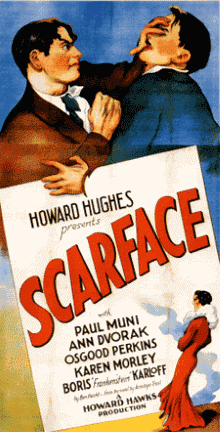
A few minutes into this film, both my wife and myself thought it seemed awfully familiar. It turned out that we had watched it before, probably a couple of years earlier when my wife wanted to sign up for a previous iteration of the same film course. Both of our memories must be failing for us to not have remembered it. But the movie is enjoyable enough that we had no difficulties with watching it a second time.
Scarface is apparently based on the life of Al Capone but I know too little of him to judge how faithful it is. Plot-wise, it’s nothing special, offering the standard story of a mobster who climbs to the top of the pack in Chicago through a combination of low cunning and sheer ruthlessness. He starts out as the right-hand man of a mafioso who uses him to kill the ruling boss of the city’s South Side, but to no one’s great surprise, his ambitions don’t end there. Of course, along with power, he gets the money, the girl and most interesting of all, the social status.
As a gangster film, it is naturally chock full of gun violence, including drive-by shootings, a recreation of the infamous Saint Valentine’s Day massacre and even a car chase scene that must have been technically quite innovative for its time. There are scenes of the newly rich Tony Camonte and his friends living it up with their new-found wealth and schmoozing up girls. It’s pretty much like every gangster film ever and all of us have watched plenty of those before. So it’s easy to miss the point and forget that it was released in 1932.
1932 is only four years after 1928 when Street Angel was released so when you stop to think about it really is rather shocking how quickly Hollywood was able to innovate and evolve. In just four years, we’ve seen the industry move from a style of film-making that is still recognizably rooted in theatrical productions to something that is almost indistinguishable from modern Hollywood. It’s no wonder why the professor included this in the list of films to study.
This also help explain one of the what feels like the most dated aspect of the film to modern audiences: the attempt to preach a moralizing message. I understand that this was mostly in order to appease the censors but it is rather cute how they try to make it sound like this is a call to arms against lawlessness when in fact the rest of the film reads like a glorification of the mobster lifestyle. The diatribe delivered by the newspaper publisher in the middle of the film feels especially egregious in this regard.
Despite its familiarity, I still found Scarface to be enjoyable mostly because of the excellent performances and memorable characters. Paul Muni is so perfect as Camonte that you need to remind yourself that he isn’t really a mobster. Equally good are his underlings including George Raft as his cool and efficient right-hand man to contrast against his own hotheadedness and Vince Barnett who tries without much success to act as his boss’ secretary. The dynamics with the leading ladies are interesting as well. I loved how Karen Morley’s Poppy keeps mocking Camonte but it flies over the head of the boorish mobster. Camonte’s own relationship with his sister Cesca is also more ambiguous and complex than first impressions suggest.
Unless you’re a student of film history, it’s probably not worth your while to watch this original version of Scarface, especially since its 1983 remake is now so highly regarded. But it’s a great film to know about and to think about in the context of the history of Hollywood.
One thought on “Scarface (1932)”